Finishing the Centerboard Trunks
Steve, over at Log of Spartina, asked how the boats were going. It’s going well, just too slow. It feels like when you’ve made the last turn onto a long tack for home, hoping the wind holds, hoping you reach land by dark. I think he’ll know what I mean. Steve sails extended trips in many of the same areas I plan to explore, and keeps a great blog of his travels, often accompanied by his friend, Bruce. I hope to meet up with him now and then for some tandem sails, and to pick his brain, as he surely has acquired a lot of very useful information.
This project has definitely made a turn. It’s time to remove all the temporary screws, make any final adjustments, and start locking everything down permanently with bronze and epoxy. There’s a lot still to do, and some of the details left will be tricky, but the list is finite and small enough that I can keep it in my head without missing anything. The end is finally in sight.
Last week I disassembled the Centerboard Cases to fine trim the parts and work out a few remaining details. I tested the mechanisms several more times, just to be sure, then drilled holes for the bronze bearing pins.
At the start of the holiday weekend, the inner surfaces were sealed in epoxy and glass. While the epoxy was still green, all the framing pieces were coated in epoxy and everything fastened together with bronze screws, permanently bedding the bronze bearing pins in place. Rather than leave those loose and removable (and prone to leaking) instead the boards are made so they can lift out easily for maintenance.
Insides of the trunks get glassed.
5/16” Bronze rod bearing pin, epoxied permanently in place.
The layers of fiberglass and epoxy add bulk to all the parts, so you have to allow for that when figuring tolerances, both inside and out. Once everything was sealed and screwed in place I could make the last miter cuts for the trunk logs and glue them in place – tricky little pieces with multiple angles and bevels and curves.
The aft end of the trunk will sit in the cockpit in plain view, so took a little more care with these cuts.
Several years ago, I came across some progress pictures of a boat built by John Blazy. John is an artist/craftsman who works in specialty plastics, and he built a beautiful wooden electric “glass bottom boat” for viewing life underwater. To keep the epoxy from sticking to his clamps, he put a layer of plastic over the scarfs during glue-up, and discovered a neat trick for working with fiberglass laminations. (His original pages of photos and descriptions have gone dark, but there’s a link to his Duckworks article here.) If you roll a sheet of thin, sturdy, but flexible plastic into the first layer of fiberglass and epoxy, the plastic will peel away when the epoxy cures, leaving a perfectly smooth flat surface. This has several huge advantages over the conventional method.
Normally, you lay down the first coat, squeegee off the excess, wait, add another coat, wait, add another coat, wait, then sand and sand and sand until smooth. Using John’s method, you do it all in one step, and get far better results. Not only is it faster, but it uses less epoxy, which is both heavy and very expensive. The two extra layers of epoxy you add the old way just build a thick layer on top of the fabric, enough that you can sand out irregularities, they don’t actually add any strength. This new method cuts down on work, weight and expense. Brilliant! I couldn’t wait to try it.
Unfortunately, it only works on flat surfaces and simple curves. It would have been perfect for my first boat, built around the same time as John’s, but that was before I found his photos. A Melonseed is all compound curves, except in two places – the Centerboard Case, and the Transom – so, this was my first chance to test it out. After doing all four outside surfaces of the trunks I can say, unequivocally, it works great. It is awesome.
At work we had a roll of Mylar left over from the film and rubylith days. One of the guys saved it from the dumpster. He cut me a couple of big pieces a year ago that I set aside for just this purpose.
After wetting out the glass with a heavy dose of epoxy, enough to more than fill the weave, you curl the plastic onto the surface, trying to trap as little air underneath as possible. Then, with a roller, slowly chase out any remaining bubbles. A rubber roller with a little give would work better, but all I had was a hard plastic one. Still, after a few minutes it was all clear.
Once it cures well beyond the sticky stage, a firm quick tug, like removing a bandage, pulls the plastic off clean. If you wait until it’s fully cured when it will release even easier, almost fall off, but then trimming off the excess glass in the hardened epoxy becomes more difficult.
Believe it or not, below is the finished job after one coat, with no sanding or scraping. That’s not the Mylar, that’s raw epoxy, ready to prep and varnish.
The cool thing about this is you can work on vertical surfaces, too, without worrying about drips and sags. I’ll definitely use it again on the Transoms.
One more thing off the list.


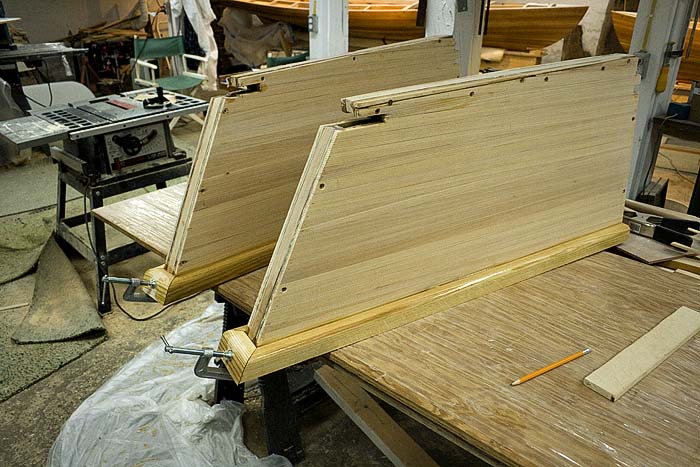
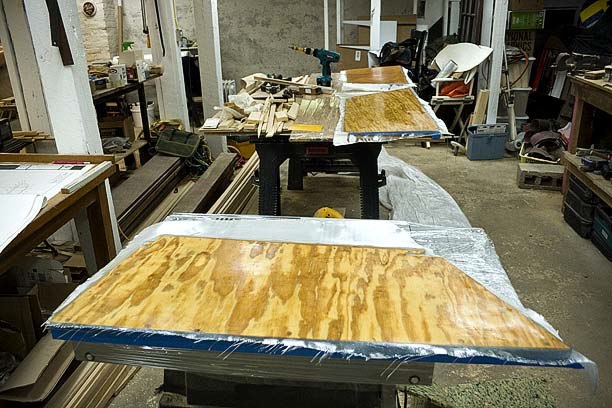



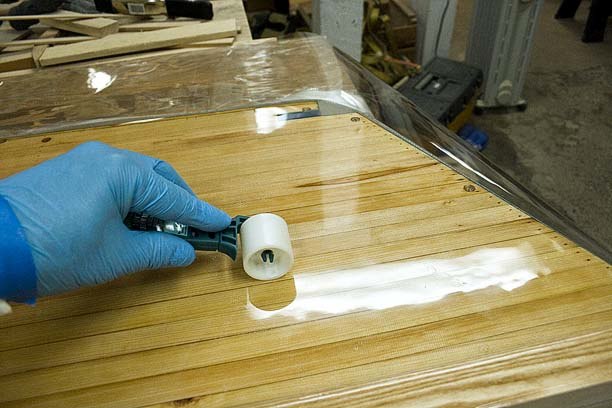
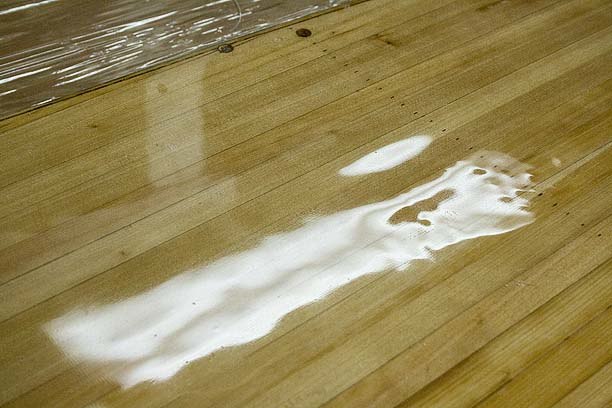

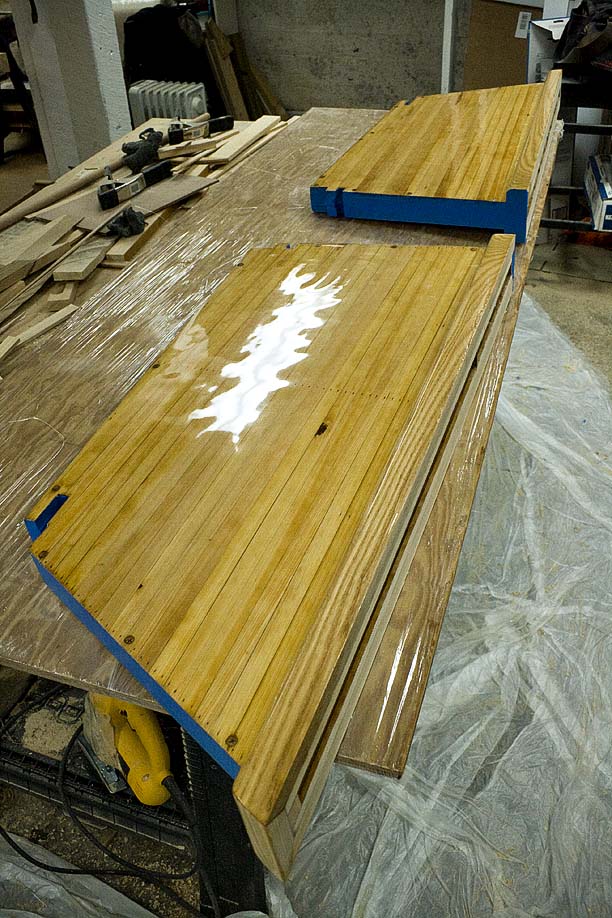
Wonder if o0ne could use the mylar o0n the decks. Do u know where mylar is commercially available?
Tuesday, June 15, 2010 – 06:10 PM
Art supply stores would be a good place to start. Prices can vary a lot, so it’s a good idea to shop around.
I think pretty much any thick, slick, transparent plastic would work, so use your imagination. The same exact stuff can cost four times as much when sold for one purpose than another (“what the market will bear”). Heavy clear PVC, blister pack material, etc.. Saran wrap would work if it were thicker and not so stretchy. Builder plastic in rolls might work, if it’s smooth enough. It only has to be transparent enough that you can see to roll out the bubbles underneath. Mylar is just one trade name for Polyester film.
http://en.wikipedia.org/wiki/Polyethylene_terephthalate
I would say see what you can get your hands on locally and test it out on some scrap first. Most anything will work, but you’ll want to be sure before trying it on a project you already have a lot of hours in.
Wednesday, June 16, 2010 – 10:11 PM